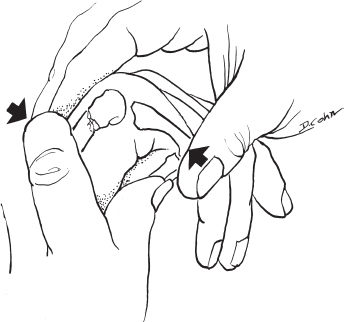41
Metacarpal Neck Fractures
Kostas J. Constantine and Thomas R. Kiefhaber
History and Clinical Presentation
A 20-year-old man was involved in a street brawl, in which he swung at but missed his opponent and struck a wall, causing immediate pain and swelling of his dominant right hand. Two days later, he presented to the emergency room complaining of continuing discomfort despite ice and elevation.
Physical Examination
Swelling and ecchymosis were noted, centered over the dorsal ulnar half of the hand. When viewed dorsally, the fifth metacarpal head lacked the prominence of the other digits. Tenderness was maximal at the fifth metacarpal neck, and palmar palpation revealed fullness at the level of the metacarpophalangeal (MP) joint. When the patient was asked to actively extend his small finger, the MP joint hyperextended 5 degrees, but he was unable to fully extend his proximal interphalangeal (PIP) joint (minus 20 degrees of full extension). When the patient made a fist, the small finger rotated toward the thenar eminence and was overlapped by the ring finger. There were no open wounds, and no other areas of tenderness localized. Two-point discrimination and vascular status were intact.
PEARLS
- Acceptable reduction:
 Index/long <10–15 degrees
Index/long <10–15 degrees
 Ring/small <30-40 degrees (up to 70 degrees if greater than 10 to 14 days)
Ring/small <30-40 degrees (up to 70 degrees if greater than 10 to 14 days)
- If apex-dorsal angulation is greater than acceptable, attempt closed reduction using Jahss maneuver.
- If unstable reduction, malrotation, or pseudoclawing, and less than 10 days postinjury, operative percutaneous pinning is indicated.
- Open reduction is rarely indicated, but may be necessary and should allow for early range of motion.
PITFALLS
- Examine for malrotation or pseudoclawing on extension.
- Do not splint in the Jahss position because of risk of PIP flexion contracture and skin necrosis.
- If concerned about stability, follow radiographs closely the first 2 weeks after closed reduction and splinting.
- Incision and drainage should be done for any wound over the MP joint, and it should be left open.
Differential Diagnosis
Metacarpal neck fracture
Other metacarpal/proximal phalangeal fracture
Metacarpophalangeal dislocation
Metacarpophalangeal joint infection
Sagittal band/extensor tendon/collateral ligament injuries
Diagnostic Studies
Diagnostic Studies
Posteroanterior, lateral, and oblique radiographs revealed a fifth metacarpal neck fracture with 60 degrees apex dorsal angulation and volar comminution (Fig. 41–1). No other abnormalities were noted.
Diagnosis
Fifth Metacarpal Neck Fracture (“Boxer’s Fracture”)
The mechanism of injury, examination, and radiographic findings confirm the diagnosis of a fifth metacarpal neck (or “boxer’s”) fracture. When applied to the fifth metacarpal, “boxer’s fracture” is a misnomer because professional fighters are more likely to fracture their index and middle metacarpal necks. Breaking the small or ring metacarpal neck is more often seen in weekend pugilists who use poor boxing technique.

The metacarpal neck is the most common site of fracture resulting from a clenched fist blow. Apex dorsal angulation occurs as a result of three factors:
- The volar moment arm of the intrinsic muscles flexes the metacarpal head.
- The force vector causing the fracture is from a dorsal to palmar direction.
- Invariably, there is some degree of volar comminution at the fracture site.
Nonsurgical Management
Stay updated, free articles. Join our Telegram channel

Full access? Get Clinical Tree








